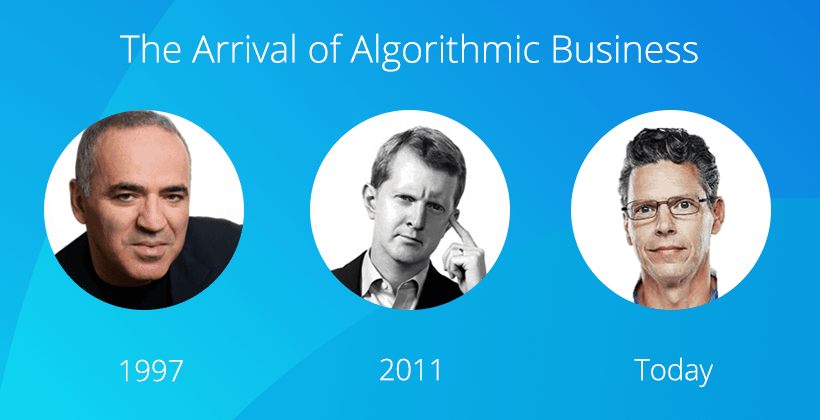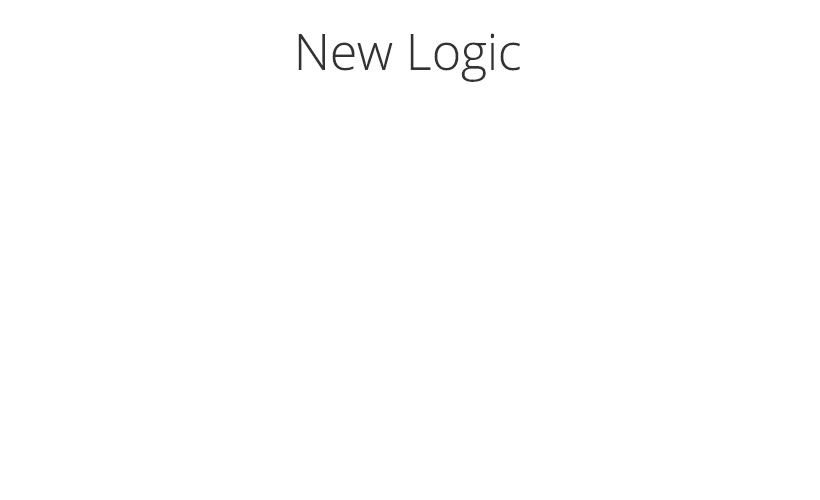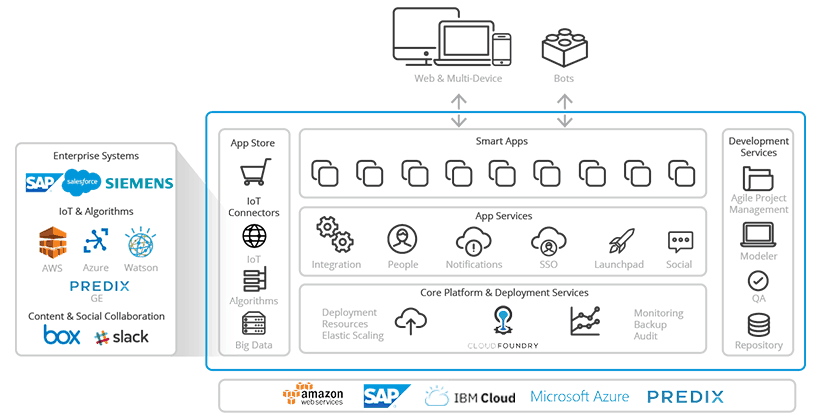We are on the cusp of a revolution in information technology. For decades, IT served the purpose of enabling businesses with administrative systems and technologies to increase employee productivity, improve business operations, and interact with customers and business partners.
A nexus of technologies like Cloud, Internet of Things (IoT), Big Data and Artificial Intelligence (AI) now make IT a driver of business innovation and a source of revenue. Marc Andreesen penned this idea six years ago in his famous WSJ article “Why software is eating the world”. The pace of technology development has only accelerated since.
The Power of IBM Watson
One of my favorite examples to highlight the disruptive nature of these technologies is IBM Watson, a set of cognitive services for natural language processing, information retrieval, knowledge representation, automated reasoning, and machine learning.
During presentations, I often show this slide and ask the audience if they know who these gentlemen are, and what they have in common.

The man on the left is Gary Kasparov, the world chess master who was beaten by IBM Deep Blue in 1997. In the middle, we find Ken Jennings, the 74-times Jeopardy winner, who was defeated by Deep Blue’s successor Watson. The last person is an anonymous doctor who benefits from IBM Watson advising on a diagnosis – treatment combination that offers the highest chance of cure.
Watson is IBM’s moonshot, as IBM CEO Ginni Rometty stated publicly on various occasions. It has grown into a rich portfolio of AI- and cognitive services powering industry solutions for Financial Services, Healthcare, Education, IoT, and Customer Engagement.
New Patterns of Innovation
Watson enables new patterns of innovation using data to drive growth, as Rashik Parmar, IBM Distinguished Engineer and previously President of IBM’s Academy of Technology, described in a Harvard Business Review article he co-authored.
I had the pleasure of meeting Rashik recently at Gartner Symposium in Barcelona, where he gave a presentation on The Anatomy of Digital Disruption. I was intrigued by one particular slide he used during his session, explaining how the “New Logic” works.

We’re all familiar with the idea that we base our decisions on information that we get from combining data and analysis. Rashik explained that by adding context to the information, we gain valuable insight. And if we could act on insight, we’re able to focus on achieving a particular business outcome.
Take Insurance claims processing as an example. A property insurer may see an increase in claims caused by water leakage. The traditional model would be to raise policy price to maintain margins. If, however, the leakage could be detected pro-actively through an IoT solution with sensors in the building’s water management system, the customer could be notified before significant damage was done. This results in claim avoidance for the insurer and saves the customer from business disruption.
Smart Apps Enable New Experiences
IoT, big data and machine learning technologies are shaping the next generation of business applications. Predictions about the proliferation of connected things vary from 20 to 50 billion devices by 2020, depending on which analyst firm you ask. While even conservative predictions are mind-boggling, we should keep in mind that IoT ultimately is not about ‘things’. It’s about making sense of the sensor data in order to deliver new services and experiences through smart apps. These smart apps power innovative digital enterprises by being:

The Challenge of Keeping Up with Business Demand
As these technologies and business paradigms emerge at a dizzying pace, application development must move faster to keep up with the demand for new software solutions.
Through 2021, market demand for app development will grow at least five times faster than IT’s capacity to deliver it.” – Gartner
Many organizations struggle with:
- Lack of Agility– Application development for digital initiatives requires rapid experimentation, frequent iteration and close collaboration between business and IT. Traditional development approaches don’t facilitate the required speed and agility, not to mention active involvement from the business.
- Technical Complexity– Teams often struggle to master the complexity of app development, applying a modern (microservices) architecture and leveraging emerging technologies.
- Skills Shortage – Digital initiatives require scarce, hard-to-find skills spanning IoT technology, integration, data management, analytics, and app development. According to Gartner, 49 percent of CIOs expect to experience IT skills shortages in the next 12 months.
The Power of Low-Code Platforms
To address the above-mentioned challenges, a new category of application development platforms is on the rise. Low-code, or High Productivity Application Platform as a Service (hpaPaaS) is a fast-growing technology market uniquely suited to help IT leaders and their teams to speed application delivery.
According to Gartner, hpaPaaS “provides application development, deployment and execution in the cloud using declarative, model-driven application design and one-step deployment.” In other words, hpaPaaS abstracts the technical complexity associated with traditional software development, enabling a broader range of users to rapidly build applications.
Business units driving digital initiatives with the need for speed can now build apps at a lightning pace, without IT losing control on critical aspects like quality, security, and scalability.
A leader in this space, Mendix offers a fast and easy way to create and continuously improve smart apps at scale.
- It’s fast because it supports visual development, supplemented with a rich app store with hundreds of building blocks to compose apps. A benchmark study showed that development is up to 10 times faster with 70 percent fewer resources compared to traditional development in Java or .NET.
- It’s easy because visual development allows non-technical developers to build sophisticated business applications that meet enterprise needs. Developers can focus 100 percent on functionality versus spending time managing underlying technology. So, the pool of resources to build apps is extended beyond already-scarce professional developers.

The essence of this low-code platform is that it abstracts away from the technical complexity associated with traditional software development, enabling a broader range of users to rapidly build applications. Here’s how it works:
- Visual Development – Helps close the talent gap by enabling both professional and citizen developers to build apps without needing to code. They can visually model their data models, UIs and logic, leveraging a marketplace of building blocks to kick-start development.
- Connectors – Minimizes technical complexity by offering out-of-the-box connectors to IBM Watson and 3rd party applications simply by dragging and dropping connector services in visual application models.
- Business & IT Collaboration – Facilitates rapid experimentation and iteration by enabling developers and business stakeholders to collaborate across the complete application lifecycle, from ideation and requirements gathering to team development and feedback management.
- Scalability and High Availability – Enables your team to start small with experimentation and scale easily, without needing to rework the application architecture. Leveraging underlying technologies like Cloud Foundry and Docker, the platform offers built-in application resilience and high availability.
- 1-Click Cloud Deployment – The 1-click deployment function allows for seamless provisioning of apps on IBM Cloud, including staging to test, acceptance and production environments.
- Central App Management – All applications can be managed from a single dashboard in IBM Cloud, ensuring availability, security, performance and scalability.
Build Apps from Simple to Mission Critical
Across the board, we see customers building apps for four main use cases:
- Innovation– Generating new revenue streams for new (digital) products/services that often leverage new technologies such as IoT and Machine Learning.
- Improve customer engagement with web and mobile apps supporting consistent brand experience across channels.
- Improve workforce productivity by automating manual processes and covering ‘white space’ application needs.
- Migrate legacy systems to the cloud, reducing cost and improving compliance.
With a rapid application development toolset, it’s easier than ever to deliver applications that not only help fulfill business strategy, but also satisfy diverse end users. You can build once for all devices, designing enhanced user interfaces and customer experiences that include native mobile features and full offline functionality.
Applications built on Mendix can scale from limited departmental use to mission-critical customer portals serving more than a million consumers.
Leverage IBM Cloud to Build Your Next Generation Apps
IBM and Mendix have been working together leveraging the joint Cloud Foundry foundation as well as Docker and Kubernetes deployments, which makes it easy for IBM customers to run Mendix on IBM Cloud.
Because of the steep increase in demand for low-code solutions, we have entered into a strategic partnership with IBM. Customers will benefit from IBM’s range of cloud deployment options from Public Cloud to Private Cloud, data residency guarantees, and the possibility to infuse cognitive throughout your company.
If you want to learn more about the partnership, please contact us. We’re looking forward to the conversation.

